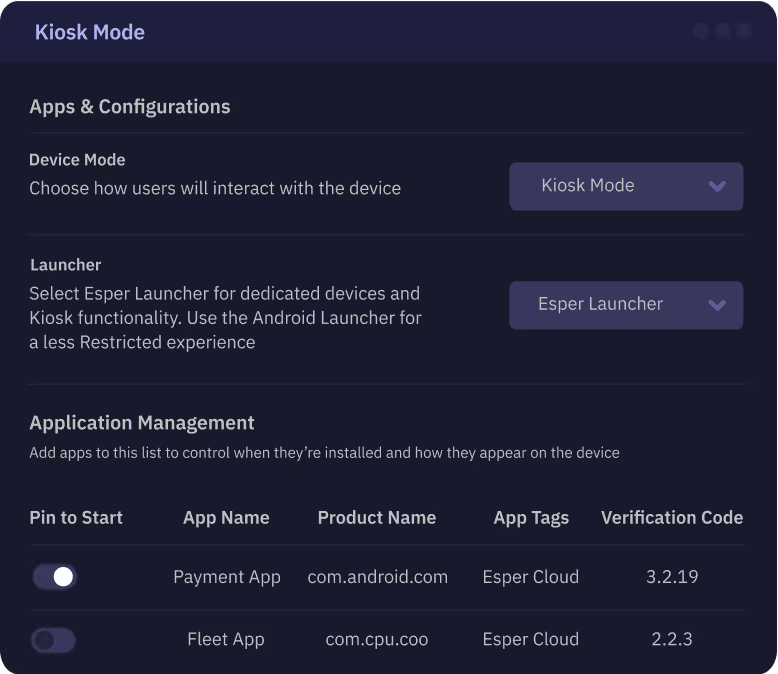
Provision smarter, scale up faster, with seamless device onboarding
Scaling your device fleet shouldn’t slow you down. Driving innovation takes meticulous planning, and traditional provisioning is complex and time-consuming. Whether you need to grow your Android device fleet, quickly onboard dozens of new iPads, or deploy a mixed fleet of thousands across the globe, you can provision faster, smarter, and at scale with Esper.

Manual provisioning instructions can range from a handful of steps to dozens of pages, draining resources and increasing the risk of costly errors. Esper’s provisioning options significantly reduce manual setup and eliminate unnecessary touchpoints, freeing your team to focus on what matters most — driving growth and innovation.





.avif)

Guarantee that every user has the exact experience you want — nothing more, nothing less.

Fully lock down devices to prevent misconfiguration and other tinkering that leads to costly troubleshooting and maintenance.

Limit devices to essential functions, eliminating employee distractions and customer confusion.

Shield devices from unauthorized access and modifications, keeping sensitive company data safe.

Purpose-built devices have a job to do. From point of sale systems to digital kiosks, Android to iOS, these devices are central to modern business interactions and revenue generation. When they deviate from their intended function, operations grind to a halt, causing customer frustration and lost revenue.

Don’t let an unsophisticated kiosk feature bring down your business. Esper’s hardened kiosk mode can’t be bypassed, offering robust protection for valuable hardware assets while ensuring every device in your fleet is always doing what it’s supposed to.

Complex provisioning methods stunt scalability. Growth takes a back seat when IT teams spend more time provisioning than innovating. Troubleshooting becomes the norm, and scaling is overshadowed by the need to keep operations running, hindering productivity and stifling innovation.
With options like 6-Tap and QR code scanning on Android and Apple Business Manager on iOS, Esper helps you onboard quickly and efficiently. For the ultimate in truly touchless onboarding, Seamless Provisioning does all the heavy lifting for you—just power on your devices, and they’re ready to go.

With proprietary features like real-time telemetry and seamless provisioning, organizations across industries can rely on Esper to provide cutting-edge solutions that are flexible enough to grow with scaling enterprise fleet.



Esper made it so much easier to not only build our product but to provision and ship our tablets to our customers. Switching from provisioning devices one-by-one to their more automated provisioning options has saved us a lot of time.



The Esper provisioning process is as streamlined as it can be. This is critical, especially for large fleets of devices. Operative costs are greatly optimized when having as little set-up and maintenance as possible as Esper is able to deliver.



With proprietary features like real-time telemetry and seamless provisioning, organizations across industries can rely on Esper to provide cutting-edge solutions that are flexible enough to grow with scaling enterprise fleet.


The Esper provisioning process is as streamlined as it can be. This is critical, especially for large fleets of devices. Operative costs are greatly optimized when having as little set-up and maintenance as possible as Esper is able to deliver.

Device provisioning is defined as setting up a device to work in a specific manner. How detailed that provisioning process is, however, can vary wildly. Sometimes it might mean something simple like disabling or enabling certain features and installing a few apps. Other times, it might mean replacing the entire operating system for specialized functionality.
Provisioning works hand-in-hand with enrollment and configuration. In a typical deployment scenario, each of these would be handled manually, which makes the deployment process cumbersome and time-consuming. Fortunately, not all provisioning processes are the same.
Yes, enrollment is typically part of the device provisioning process and involves registering the device and associating it with specific user accounts or policies.
Provisioning is the broader process of preparing a device for use, while configuration refers to the specific customization of settings and parameters on a device.
Yes, provisioning is typically part of the device deployment process, which involves introducing and setting up devices within a system or infrastructure.
Device deployment involves the physical or virtual distribution and installation of devices in their intended locations, including tasks like logistics, transportation, installation, network connectivity, and initial configurations.